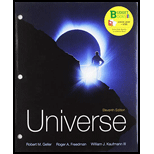
Concept explainers
(a)
The average density of a
Earth.
(a)
Answer to Problem 30Q
Explanation of Solution
Given data:
The mass of the star is
Formula used:
The average density of the star can be calculated by using the following relation:
Here,
Write the expression for the volume of a sphere.
Here,
Explanation:
Since the mass of the star is given in solar mass, convert it into standard the mass unit, that is, kilograms.
Recall the expression for the volume of a sphere.
Substitute
Recall the expression for the average density of a star.
Substitute
Conclusion:
The average density of the dwarf star,
(b)
Whether or not the star’s density is the same as the density of about an elephant per teaspoon, along with proper calculation.
(b)
Answer to Problem 30Q
No, the star’s density is approximately twice that of about an elephant per teaspoon.
Explanation of Solution
Given data:
Let us consider a general elephant with mass 4000 kg and an ordinary teaspoon with volume
Formula used:
Write the expression of the density as -
Here,
Explanation:
The density will be calculated as:
Substitute
Compare
Conclusion:
The density of the dwarf star is approximately twice that of about an elephant per teaspoon. So, the provided statement is incorrect.
(c)
The escape speed required for a gas to eject from the star’s surface.
(c)
Answer to Problem 30Q
Explanation of Solution
Given data:
The mass of the star is
Formula used:
Write the expression for escape speed.
Here,
Explanation:
The escape speed is the minimum speed required to send an object out of the gravitational field of the body it is being sent from.
Recall the expression for escape speed.
Substitute
Conclusion:
The escape speed for the gas is
Want to see more full solutions like this?
Chapter 20 Solutions
Universe - Text Only (Looseleaf)
- Say that a particular white dwarf has the mass of the Sun but the radius of Earth. What is the acceleration of gravity at the surface of the white dwarf? How much greater is this than g at the surface of Earth? What would you weigh at the surface of the white dwarf (again granting us the dubious notion that you could survive there)?arrow_forwardLook at the list of the nearest stars in Appendix I. Would you expect any of these to become supernovae? Why or why not?arrow_forwardBased on the problem attached, what is the answer for sub-item (b) if the radius of the neutron star is 67.004 km? (express your answer in the proper SI unit and without scientific notation)arrow_forward
- What is the acceleration of gravity at the surface if the white dwarf has 1.5 the mass of the sun and is only half the radius of earth?arrow_forwardwhat is the answer for sub-item (b) if the radius of the neutron star is 47.545 km? (express your answer in the proper SI unit and without scientific notation)arrow_forwardAssuming that at the end of the He burning phase of the stellar core (r < R_core) has no H or He or other metals and is composed completely of Carbon, X=Y=0, X_c = 1 ; The envelope above the core has a normal stellar composition ( r > R_core). Calculate the length of time in years that a 1M_sol and 10M_sol star will live on the horizontal branch or the time between the start and end of the He burning phase. Assume that the normal relationship between mass and luminosity holds for horizontal branch stars. Please be as detailed as possiblearrow_forward
 AstronomyPhysicsISBN:9781938168284Author:Andrew Fraknoi; David Morrison; Sidney C. WolffPublisher:OpenStax
AstronomyPhysicsISBN:9781938168284Author:Andrew Fraknoi; David Morrison; Sidney C. WolffPublisher:OpenStax Stars and GalaxiesPhysicsISBN:9781305120785Author:Michael A. Seeds, Dana BackmanPublisher:Cengage Learning
Stars and GalaxiesPhysicsISBN:9781305120785Author:Michael A. Seeds, Dana BackmanPublisher:Cengage Learning Stars and Galaxies (MindTap Course List)PhysicsISBN:9781337399944Author:Michael A. SeedsPublisher:Cengage Learning
Stars and Galaxies (MindTap Course List)PhysicsISBN:9781337399944Author:Michael A. SeedsPublisher:Cengage Learning Foundations of Astronomy (MindTap Course List)PhysicsISBN:9781337399920Author:Michael A. Seeds, Dana BackmanPublisher:Cengage Learning
Foundations of Astronomy (MindTap Course List)PhysicsISBN:9781337399920Author:Michael A. Seeds, Dana BackmanPublisher:Cengage Learning



